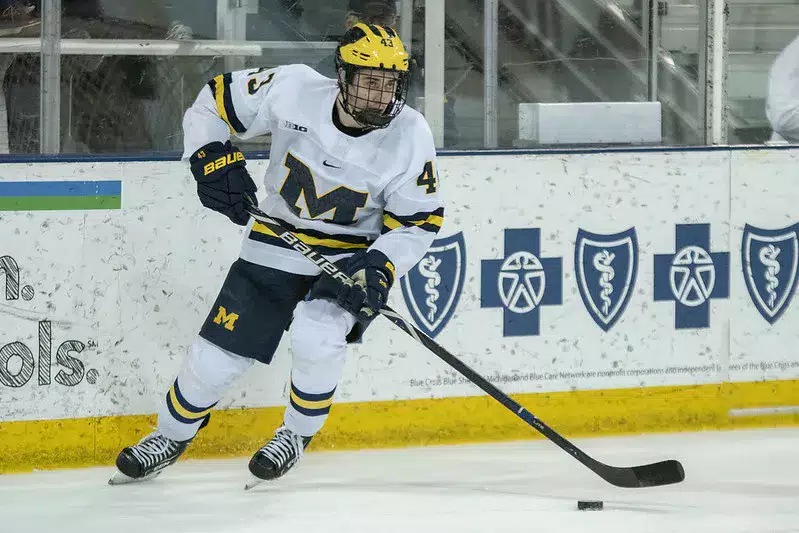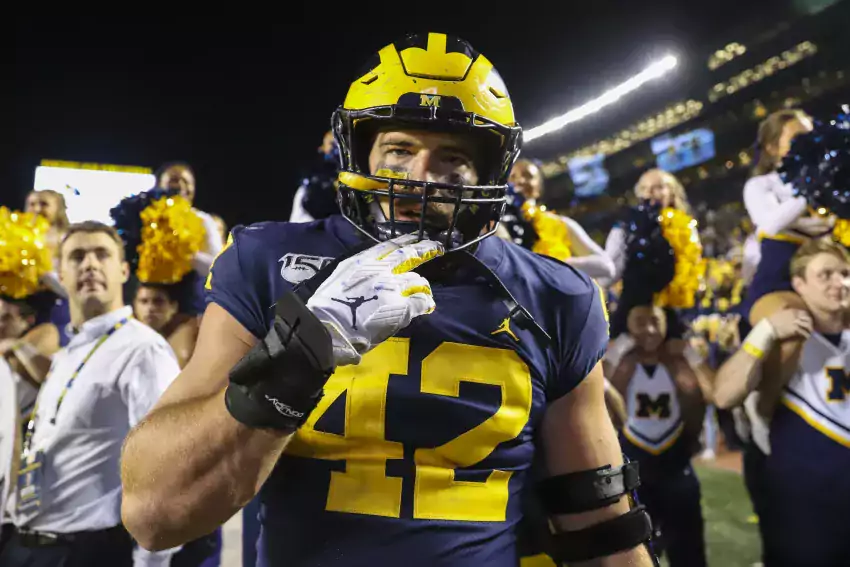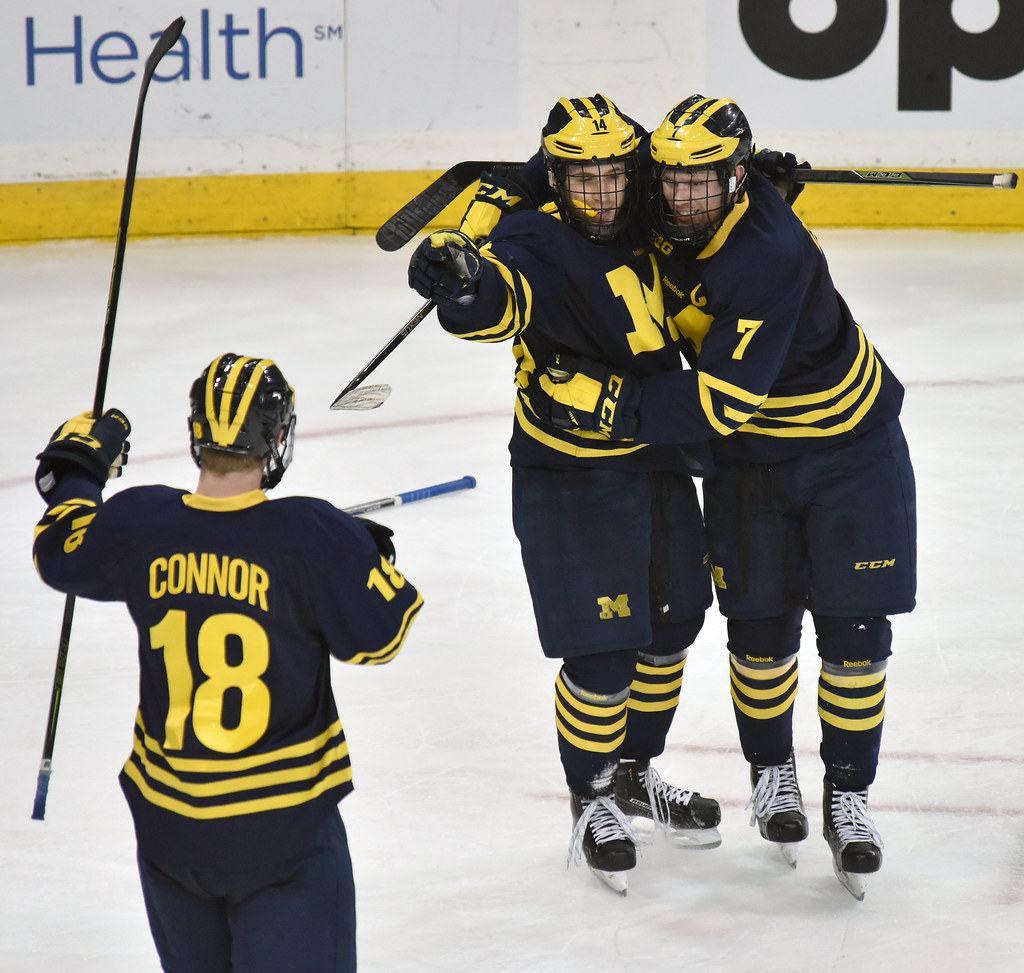tyler motte

It's been a couple years since I last wrote a "Wolverines in the NHL" update. David and I have done a segment during the season on the HockeyCast devoted to it the last couple years, but a written piece can have a wider reach and can also be more expansive. Also, since the NHL regular season recently ended, I figured this was a proper time to do it, rather than in the middle of the season like our podcast segment. With the recent explosion of Michigan players heading to professional hockey, this year's update is longer than ever, so it's being broken into two pieces. Today is Part 1, where we'll cover the established NHLers, the studs, complementary players, and role players. Tomorrow will be updates on the younger NHLers, recent retirees, and all the alumni who have fallen short of the NHL but are still playing pro hockey somewhere in the world:
The Studs
These are the players who are considered high end, All-Star caliber. They are one of the three or so best players on their given teams and are getting paid premium money in the NHL:
Quinn Hughes, D, Vancouver Canucks: Already the best defenseman from the University of Michigan to ever play in the NHL, Hughes is likely to set a new milestone (when the awards are announced in June), becoming the first Michigan alumni to ever win the Norris Trophy for the NHL's best defenseman. Michigan State (Duncan Keith), Harvard (Adam Fox), UMass (Cale Makar), Bowling Green (Rob Blake), Boston College (Brian Leetch), and Wisconsin (Chris Chelios) have all produced a Norris winner... it's about time that Michigan got one. Hughes is likely to do it, the capstone of a marvelous season that saw him score 17 goals and 75 assists for 92 points, leading the NHL in the latter two categories for defensemen (he was tied for 6th with 17 goals by a D).
Hughes became one of 12 defensemen in NHL history to ever score 90+ points in a season, which is what will likely cement his Norris case. Hughes is the engine for everything that the resurgent Vancouver Canucks do, helping the team win their division for the first time in nearly a decade. He's a dynamic offensive force and a puck possession monster who drives play over all 200 feet, which allowed the Canucks to outscore opponents 92-55 with Hughes on ice at 5v5 this regular season(!!). A brilliant passer who has evolved significantly as a shooter and defender during his NHL career, Hughes is a no doubt top five defenseman in the NHL during his age 24 season.
Dylan Larkin, C, Detroit Red Wings: Few players in the NHL may be as linked to their team's wins and losses as Dylan Larkin is to the Red Wings. Anyone who followed Detroit's season knows that, a team that seemed to be headed to the postseason before an injury to Larkin in March submarined their season. The team looked almost unrecognizable without Larkin and it's not surprising why that's the case. The Red Wings captain potted 33 goals this season, the best goals-per-game mark of his career (coming in just 68 games). He also finished above 1.00 points-per-game this season for the first time in his career, probably reaching his apex at 27 and that's fine. Larkin's a very good NHL player, an important leader off the ice and a speedy playdriver with good offensive talent on the ice, playing a premium position with legit finishing talent. Though perhaps not a superstar of the Quinn Hughes variety, there are no teams in the NHL that would turn down the opportunity to put Larkin on their roster.

[Bill Rapai]
Zach Hyman, LW, Edmonton Oilers: I listed Hyman as a complementary piece the last time I did this article, which is still probably true in the abstract (in the sense that he complements his team's superstars), but when you score 54 goals, you have to go in the stud category. That's what Hyman did this season, blowing by his career high goal total by a full 18 goals en route to a staggering total that ranked 3rd in the NHL The three seasons since Hyman signed in Edmonton has seen his goal total increase in linear fashion, from 27 to 36 to 54, this season being the apex of the 31-year-old's career. Hyman is simply the perfect fit to play alongside the NHL's best offensive player, Connor McDavid. He posts up around the net and gets fed the puck, shots in tight, tips, deflections. Very few of Hyman's 54 goals have come outside of ~5 feet from the crease, with 15 of his goals coming on Edmonton's devastating power play. It may be true that Hyman wouldn't score that many goals on a team sans McDavid and Leon Draisaitl, but the skill and hockey talent of Hyman is now undeniable. He's a really good NHL forward.
Kyle Connor, LW, Winnipeg Jets: Two years ago when I wrote this piece Connor was coming off of a season akin to what Hyman has done this season, scoring 47 goals for the Winnipeg Jets. His two seasons in the meantime have fallen short of that mark but Connor remains a high level NHL goalscorer. Connor has now played seven real NHL seasons and has scored 30 goals or at a 30+ goal pace (in the case of the 56 game COVID shortened season) in all seven of them. He remains a pretty nonexistent defensive player, instead a one-dimensional rush scorer but when you average ~38 goals per 82 games over a seven season period, it doesn't much matter what else you do. You're a legit stud.
Zach Werenski, D, Columbus Blue Jackets: Not a ton has changed for Werenski since the last time we updated this article. He remains a very good offensive defenseman, scoring 57 points this season (ranking 12th in the NHL by a defender) in 70 games. This was the most games that Werenski has played in a season since 2018-19, as injuries continue to minorly hamper him, but his play remains pretty consistent. Werenski plays on a bad team, puts up a good number of points, generally wins his minutes, and collects a huge paycheck (still earning $9.5 M annually, near the top in the league). Werenski's not an elite defenseman, but he's a good top pairing puck mover.
[AFTER THE JUMP: more players]

A note on content. You may have noticed I'm not posting every day as I have for eons. This is suddenly season preview cram time for me, to go along with no daycare for two small kids and an online semester for my wife that is extremely time consuming. Bear with us, please.
Tyler Motte on his mental health. A member of the CCM line opens up about his struggles:
Motte, now 25, paused for a moment. "Actually," he said. "There is one thing." Then the words started flowing out of his mouth before he could consider the significance.
"Earlier in the summer, I was diagnosed with anxiety and depression," Motte said. "Do we have somebody for that?"
Long and worth yoru time.
The thing Clowney lacks. Jadeveon Clowney is now a highly regarded NFL defensive end with a weird inability to convert pressures into sacks. For The Win looks into why:
Finishing off a pass rush is a skill and the numbers suggest that Clowney does not possess it. But in order to confirm that theory — and figure out why he struggles to turn pressure into sacks — I took a look at all of his pressures from the 2019 season. From there, I picked out the plays where Clowney had a significant effect on the quarterback. Here’s a cut-up of those plays…
It shouldn’t take too long to pick up on the pattern: On nearly every win, Clowney uses an inside move to beat his blocker. …
When you really dive into his tape, which NFL teams surely did this offseason, Clowney’s biggest weakness becomes readily apparent: He’s got no bend. In other words, after beating an offensive tackle upfield, he struggles to turn the corner, which makes it much easier for the tackle to recover and block him.
This was also a problem for Rashan Gary, another giant athletic freak of a defensive end, at Michigan. Gary's attempts to win to the outside were ineffective because he couldn't dip around the offensive tackle. In contrast, Josh Uche is all bend.
This doesn't mean Clowney isn't a good defensive end. He grades out well everywhere that offers grades. It does mean his production is usually limited to hurries and various pocket disruptions.
[After THE JUMP: a plea for 80 yard Ben Mason touchdowns]

[Sherman/MGoBlog]
Yesterday I was thumbing through a notebook I use for interview prep and found a projected line chart I wrote last summer for the 2015-16 hockey season. It had Tyler Motte, JT Compher, and Alex Kile on the first line; I had Kyle Connor on the second. I chortled under my breath and moved on. It was only in doing research for this piece that I rediscovered how long- two months(!)- the lines were arranged as such. It's easy to forget that Michigan started their season without Connor, Compher, and Motte together, with the trio we'll affectionately remember as the CCM line not seeing game action until the beginning of December.
Connor, Compher, and Motte launched a four-month-long assault on the Big Ten and the Michigan record books that produced numbers that will be tough to come across in the near future. They also produced the kind of moments that become seared into your sports consciousness; sports memories tend to be grounded in moments, not the chronology of events. I still remember walking up State Street after some game during the 2007-08 season and marveling at Kolarik and Porter the whole way back. I don't remember which game, but I remember exactly what it felt like to be a witness to something special. I liked Michigan hockey before 2007-08, but the credit for why I care enough to want to break down every goal scored over the course of every season falls squarely on Kevin Porter and Chad Kolarik's shoulders.
That feeling was back this year. For the first time in at least eight season we weren't just watching great players play, we were watching players play perfectly off of each other and accomplish things that caused that voice in the back of your mind to pick up decibels until it's practically screaming at you, reminding you that this is something to hold on to, something that doesn't happen every season.
The numbers give context to the memories: Connor led the nation in scoring and goals, Compher finished second in scoring nationally and led the country in assists, and Motte finished fourth in scoring nationally. Motte scored a goal in 12 straight games, a Berenson-era record; Connor ended the season with a 27-game point streak, another Berenson-era record. Connor scored more goals than any other freshman in Michigan history while finishing second in all-time freshman points. Compher had the second most assists of any junior in Michigan history. Compher, Connor, and Motte were three of the top 10 finalists for the Hobey Baker, which is just the third time in the award's history that one school has placed three players in the top 10. (Michigan also did it in 1994, when Steve Shields, Brian Wiseman, and David Oliver were finalists.)
Michigan's roster next year will look different, and it's not just because it's missing two guys (and possibly a third) who scored in droves. The way they played together is what set the CCM line apart. It's something that you don't see in hockey very often these days; creativity and communication can create beautiful plays, but the system a player is a part of has to allow the player to take some liberties for that to transpire. Michigan's system is well suited for that, and the results speak volumes not just about the system but about the way the abilities of three players blended to create a scoring threat that was nearly unstoppable.
Igor Larionov wrote a piece for The Players' Tribune that I've seen passed around NHL circles again recently, and the crux of his argument is that players are told to over-simplify their game at too early an age in order to eliminate risk. In his mind, this stifles creativity and leaves only a handful of players in the NHL who think the game three or four moves ahead and then act on those suppositions. In his words:
Our philosophy was about puck control, improvisation, and constant movement. Now, the game is all about “north-south,” chip-and-chase. We moved side-to-side and swooped around the ice looking for open spaces. A backward pass was just as good as a forward pass. You didn’t have to see your linemate. You could smell him. Honestly, we probably could have played blind.
Michigan had three boundlessly creative players on the same line. Connor's accuracy and quick release made him the perfect finisher, always open thanks to his linemates' ability to maintain possession and positioning near the net. Compher had some of the finest olfaction of any Michigan skater I've seen, seemingly throwing the puck around blindly only to put it precisely on the tape of his teammate's stick. Motte could turn and lift a puck from a sharp angle in such a way that the puck seemed to explode off his blade; he was the perfect netfront presence.
With a few exceptions, these three showed that you can be responsible defensively while also being creative offensively, and in the process they crafted moments that transcended box scores. To borrow from Red Berenson by way of Dickie Moore, you can't buy that kind of fun.
[After THE JUMP: I empty out my "CCM line" gif folder]
28